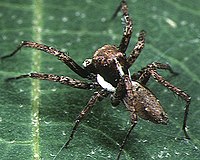
Photo from wikipedia
Abstract As one of the most abundant predators of insects in terrestrial ecosystems, spiders have long received much attention from agricultural scientists and ecologists. Do spiders have a certain controlling… Click to show full abstract
Abstract As one of the most abundant predators of insects in terrestrial ecosystems, spiders have long received much attention from agricultural scientists and ecologists. Do spiders have a certain controlling effect on the main insect pests of concern in farmland ecosystems? Answering this question requires us to fully understand the prey spectrum of spiders. Next‐generation sequencing (NGS) has been successfully employed to analyze spider prey spectra. However, the high sequencing costs make it difficult to analyze the prey spectrum of various spider species with large samples in a given farmland ecosystem. We performed a comparative analysis of the prey spectra of Ovia alboannulata (Araneae, Lycosidae) using NGS with individual and mixed DNA samples to demonstrate which treatment was better for determining the spider prey spectra in the field. We collected spider individuals from tea plantations, and two treatments were then carried out: (1) The DNA was extracted from the spiders individually and then sequenced separately (DESISS) and (2) the DNA was extracted from the spiders individually and then mixed and sequenced (DESIMS). The results showed that the number of prey families obtained by the DESISS treatment was approximately twice that obtained by the DESIMS treatment. Therefore, the DESIMS treatment greatly underestimated the prey composition of the spiders, although its sequencing costs were obviously lower. However, the relative abundance of prey sequences detected in the two treatments was slightly different only at the family level. Therefore, we concluded that if our purpose were to obtain the most accurate prey spectrum of the spiders, the DESISS treatment would be the best choice. However, if our purpose were to obtain only the relative abundance of prey sequences of the spiders, the DESIMS treatment would also be an option. The present study provides an important reference for choosing applicable methods to analyze the prey spectra and food web compositions of animal in ecosystems.
Journal Title: Ecology and Evolution
Year Published: 2021
Link to full text (if available)
Share on Social Media: Sign Up to like & get
recommendations!